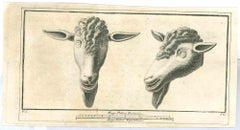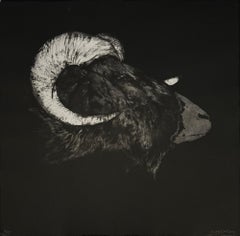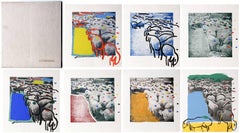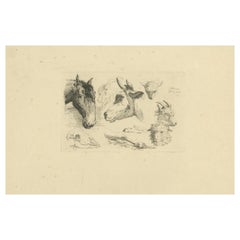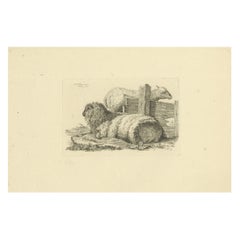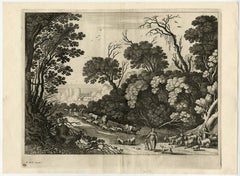Etchings Of Sheep
Ancient Roman Statues of Sheep - Original Etching - 18th Century
Located in Roma, IT
Ancient Roman Statues of Sheep, from the series "Antiquities of Herculaneum", is an original
Category
18th Century Old Masters Figurative Prints
Materials
Etching
$354
H 4.73 in W 9.06 in D 0.04 in
Tête de Bélier, etching of big horn sheep by Marjan Seyedin
Located in Palm Springs, CA
Portrait of a big horn sheep against a black background. Image is printed to the edge of the sheet
Category
2010s Contemporary Animal Prints
Materials
Etching
Sheep Portfolio of 7 Conceptual Etchings and Screenprints by Menashe Kadishman
By Menashe Kadishman
Located in Long Island City, NY
Artist: Menashe Kadishman, Israeli (1932 - 2015)
Title: Sheep Portfolio
Year: 1981
Medium
Category
1980s Conceptual Animal Prints
Materials
Etching, Screen
Detailed Etching of Horse, Cow, Goat, and Sheep Heads by Oberman, 1809
Located in Langweer, NL
elements. Here’s a comprehensive description of the etching:
Composition:
1. Animal Heads:
- The print
Category
Antique 1810s Dutch Prints
Materials
Paper
$416 Sale Price
25% Off
H 10.63 in W 16.93 in D 0.01 in
Etching of Three Sheep Resting by Fence: Farm Animal Study, by Oberman in 1810
Located in Langweer, NL
sheep lying down on the grass, with its body turned slightly away from the viewer. The detailed etching
Category
Antique 1810s Prints
Materials
Paper
$444 Sale Price
20% Off
H 10.63 in W 16.93 in D 0.01 in
Recent Sales
Untitled - A herd of cows and sheep fording a stream in a forest.
By Nicolas Perelle
Located in Zeeland, Noord-Brabant
Etching on hand laid paper. Watermark: Coat of arms of Rioms (= ca. 1660).
Undescribed copy after
Category
17th Century Landscape Prints
Materials
Etching
Antique Print of Sheep by Robert Hills, 1802
Located in Langweer, NL
'Etchings of Sheep from nature by Robert Hills'.
Category
Antique Early 19th Century Prints
Materials
Paper
Detailed Etching of Sheep and Lamb Heads: Farm Animal Study by Oberman, 1809
Located in Langweer, NL
description of the etching:
Composition:
1. Sheep Heads:
- The print prominently features the heads of
Category
Antique 1810s Prints
Materials
Paper
H 10.63 in W 16.93 in D 0.01 in
Karel Dujardin Etching of Recumbent Sheep, 1655
By Karel Dujardin
Located in Brooklyn, NY
Etching by Dutch/Italian artist Karel Dujardin (1622-1678). Numbered 35 in plate.
From the
Category
Antique Mid-17th Century Italian Prints
People Also Browsed
Richard Diebenkorn, Olympic Lithograph, 1984, Deluxe signed Lt Ed w/official COA
By Richard Diebenkorn
Located in New York, NY
Richard Diebenkorn
1984 Olympic Lithograph (Hand signed deluxe limited edition w/Olympic Committee COA), 1982
Lithograph with offset lettering on 100% cotton Parsons Diploma Parchmen...
Category
1980s Abstract Abstract Prints
Materials
Lithograph
Seascape I - large format photograph of blue tone horizon and sea
By Frank Schott
Located in San Francisco, CA
large scale photograph capturing the soothing tones of nature's calming blue hour color palette
Seascape I by Frank Schott
48 x 64 inches / 122cm x 162cm
signed edition of 7
30 x ...
Category
21st Century and Contemporary Contemporary Abstract Prints
Materials
Archival Paper, Photographic Paper, Archival Pigment, Archival Ink, Giclée
$4,400
H 48 in W 64 in D 0.03 in
Study for a Monument in the Heroic/Erotic/Academic/Comic Style Claes Oldenburg
By Claes Oldenburg
Located in New York, NY
This sensuous and playful scene is characteristic of Oldenburg’s printmaking ouevre: a veritable heap of women displaying various expressions of ecstasy and repose. The loose sketche...
Category
1970s Modern Figurative Prints
Materials
Etching
$1,125
H 37.75 in W 41.75 in
Utagawa Kuniyoshi -- Sho'onko Ryoho 小溫侯呂方 (Lu Fang)
By Utagawa Kuniyoshi
Located in BRUCE, ACT
Title: Sho'onko Ryoho 小溫侯呂方 (Lu Fang)
form Series: Tsuzoku Suikoden goketsu hyakuhachinin no hitori 通俗水滸傳濠傑百八人一個 (One of the 108 Heroes of the Popular Water Margin)
Utagawa...
Category
1820s Portrait Prints
Materials
Woodcut
$1,600 Sale Price
50% Off
H 14.65 in W 9.93 in
Patrizia Italiano Head Vases Collection ( x 11)
By Patrizia Italiano
Located in Milan, IT
Extraordinarily crafted and decorated by hand according to the ancient Sicilian traditions of Moor's heads manufacturing, these gorgeous ceramic sculptures can be used as a flowerpot...
Category
2010s Italian Vases
Materials
Ceramic
Topiary V - large format photograph of ornamental shaped tree
By Frank Schott
Located in San Francisco, CA
from a series of photographic observances capturing the antics of urban gardening's tree trimming and striking art of topiaries' green minimalism
Topiary V by Frank Schott
40 x 30 ...
Category
21st Century and Contemporary Contemporary Landscape Prints
Materials
Photographic Paper, Giclée, Archival Pigment
$2,200
H 40 in W 30 in
" les Dioscures " . Exemplaire d'auteur .E.A
By Jean Cocteau
Located in CANNES, FR
Jean Cocteau ( 1889-1963 )
" les Dioscures " .
conceived in 1958 and executed in an edition of 40 .
This one : Exemplaire d'auteur .E.A .
" collection of Madeline -Jolly "
partia...
Category
1950s Art Deco Portrait Prints
Materials
Ceramic
Sheep 6, Conceptual Etching with Screenprint by Menashe Kadishman
By Menashe Kadishman
Located in Long Island City, NY
Artist: Menashe Kadishman, Israeli (1932 - 2015)
Title: Sheep Portfolio 6
Year: 1981
Medium: Screenprint and Etching, signed in pencil
Edition: 65, AP 5
Size: 33.5 x 31 in. (85.09 x...
Category
1980s Conceptual Animal Prints
Materials
Etching, Screen
Pigging Out at the Diner, Surreal Anthropomorphic Pig Satirical Illustration
Located in Soquel, CA
A satirical, surreal depiction of a pig at a lunch counter by an unknown artist (20th Century). This scene, full of symbols and satire, portrays the anthropomorphic pig with its face...
Category
Late 20th Century Surrealist Figurative Paintings
Materials
Oil, Illustration Board
$680 Sale Price
20% Off
H 28.5 in W 20 in D 2 in
Original Vintage Art Deco Print by Margery Lawrence, 1921.
Located in St Annes, Lancashire
Wonderful image by Margery Lawrence
Tipped in plate. On green card
Lithograph.
Published 1921
The measurement given is the card size not the actual printed image.
Category
Vintage 1920s British Art Deco Prints
Materials
Paper
1980s Keith Haring Pop Shop collectible (Keith Haring three-eyed)
By Keith Haring
Located in NEW YORK, NY
Keith Haring Pop Shop bag c.1987:
Rare original 1980s Keith Haring Pop Shop collectible featuring Keith Haring’s Three Eyed Smiling Face on a double-sided vinyl pouch. A classic 1980...
Category
1980s Pop Art Figurative Prints
Materials
Offset, Plastic, Lithograph
Camarades Ouvriers, May 1968 Original Vintage Poster
Located in Melbourne, Victoria
Histories of May 1968 have juxtaposed the cultural and political implications of the events. Many have viewed the student protests as a cultural rebellion focused on freedom of expre...
Category
Vintage 1960s Posters
Materials
Paper
$608 Sale Price
20% Off
H 34.26 in W 22.84 in D 0.04 in
French Bovine Hoof Table Lamps with Shades
Located in San Francisco, CA
Hoof table lamps with ivory shades. Sold separately. The taxidermy is mounted upon a small wooden shield, featuring a simple switch, wired for EU usage. The shades that are included ...
Category
Early 20th Century French Rustic Table Lamps
Materials
Animal Skin, Wood
Israeli Modernist Silkscreen Print Kotel Wall Jerusalem Kadishman Lithograph
By Menashe Kadishman
Located in Surfside, FL
On BFK Rives French art paper. This is a Photograph silkscreen print of the Kotel, Western Wall in Jerusalem overlaid with Kadishman drawing.
Menashe Kadishman was born in Tel-Aviv ...
Category
1970s Pop Art Landscape Prints
Materials
Lithograph
Bacon, Le Boeuf, 1986
By Francis Bacon
Located in Fairfield, CT
Artist: After Francis Bacon (1909-1992)
Title: Le Boeuf, exhibition poster
Year: 1986
Medium: Offset Lithograph on premium paper
Size: 30.75 x 18 inches
Condition: Excellent
Notes: P...
Category
1980s Abstract Expressionist Abstract Prints
Materials
Lithograph, Offset
Sheep 5, Conceptual Pop Art Screenprint by Menashe Kadishman
By Menashe Kadishman
Located in Long Island City, NY
Artist: Menashe Kadishman, Israeli (1932 - 2015)
Title: Sheep Portfolio 4
Year: 1981
Medium: Screenprint and Etching, signed in pencil
Edition: 65, AP 5
Size: 33.5 x 31 in. (85.09 x...
Category
1980s Conceptual Animal Prints
Materials
Screen
$750
H 33.5 in W 31 in
Get Updated with New Arrivals
Save "Etchings Of Sheep", and we’ll notify you when there are new listings in this category.
Etchings Of Sheep For Sale on 1stDibs
Find a variety of etchings of sheep available on 1stDibs. There are many contemporary, Old Masters and Impressionist versions of these works for sale. These items have been produced for many years, with earlier versions available from the 18th Century and newer variations made as recently as the 21st Century. If you’re looking to add etchings of sheep that pop against an otherwise neutral space in your home, the works available on 1stDibs include that feature elements of gray, gold, brown, purple and more. Many versions of these artworks are appealing in their rich colors and composition, but Ans Zondag, David Loggan, Rudolph Carl Gorman, Francois-Xavier Lalanne and Menashe Kadishman produced especially popular works that are worth a look. The range of these distinct pieces — often created in bronze, metal and engraving — can elevate any room of your home.
How Much are Etchings Of Sheep?
Prices for pieces in our collection of etchings of sheep start at $217 and top out at $48,693 with the average selling for $2,048.
Questions About Etchings Of Sheep
- What is etching?1 Answer1stDibs ExpertSeptember 25, 2019
Etching is a method of making prints using metal plates onto which a design has been incised by acid.
- What is etched glass?1 Answer1stDibs ExpertFebruary 22, 2021Etched glass is a type of decorative glass which is the result of small cuts made to the glass. The cuts, which appear white, typically form patterns or images.
- What is vintage etching?1 Answer1stDibs ExpertApril 5, 2022Vintage etching is a term that refers to a specific type of print produced between 50 and 100 years ago. Printmakers produced etchings by carving images into a copper plate and then soaking it in an acid bath. Then, they applied ink to the plate and pressed it against paper or another material to create an image. On 1stDibs, find a collection of vintage etchings.
- What is an original etching?1 Answer1stDibs ExpertMarch 13, 2024An original etching is a print produced during the first production run of a print series. After making an etching plate, an artist will create a limited number of etchings. Collectively, these prints are the original etchings. They differ from restrike etchings made years later, sometimes after the death of the artist. On 1stDibs, shop a diverse assortment of etchings.
- What is a Picasso etching?1 Answer1stDibs ExpertApril 5, 2022An etching is created by cutting down a metal plate with chemicals, including acid, to achieve the desired image. The metal plate is then inked and pressed onto a piece of paper. Picasso became fascinated with etchings when he moved to Paris in the early 1900s, and would go on to pioneer new techniques with etchings throughout his career. Shop a selection of Pablo Picasso pieces from some of the world’s top art dealers on 1stDibs.
- What are the types of etching?1 Answer1stDibs ExpertSeptember 25, 2019
There is dry and wet etching.
- How do you identify an etching?1 Answer1stDibs ExpertNovember 26, 2024To identify an etching, look in the corners and on the back for an artist's signature or publisher information. Cross-referencing markings with information shared on trusted online resources can allow you to determine the artist. From there, you can browse online and print catalogues of their work to find out the title and date of the etching. In terms of how to tell an etching apart from other types of prints, one telltale sign is the appearance of slightly blurry lines along the edges. Called plate marks, these lines form from the pressure exerted by the plate during the etching process. You may need a magnifying glass to spot the plate mark on a print. If you have any difficulty with the identification process, consider enlisting the help of a certified appraiser or experienced art dealer. Shop a collection of etchings on 1stDibs.
- Why did Henry Moore draw sheep?1 Answer1stDibs ExpertMarch 13, 2024Henry Moore drew sheep for a few reasons. The British artist thought sheep were peaceful and found watching them graze to be relaxing. He also liked how they stood out against the landscape due to their coloring, likening it to the way a statue draws the eye away from the rest of its surroundings. On 1stDibs, find a diverse assortment of Henry Moore art.
- 1stDibs ExpertAugust 26, 2024The difference between etching and aquatint is technique. Invented in the 1500s, etching is a way of incising lines in a metal plate by first drawing on an acid-resistant coating, or ground, to reveal the metal beneath. The plate is then submerged in acid, which “bites” the lines into the metal plate. The ground is then removed, and the plate is inked for pressing. Etched lines tend to reveal the movement of the artist’s hand more than a technique like engraving, since the image is created on softer ground. Aquatint, a technique named for its resemblance to watercolor or ink wash, is often combined with etching to create rich tonal variations. It’s a similar process to etching, but the resin ground is more granulated, so the acid handles the metal differently. Different degrees of darkness are created based on the amount of time the plate is in contact with the acid. Find a collection of etchings and aquatint prints on 1stDibs.
- 1stDibs ExpertApril 3, 2024The difference between a lithograph and an etching is that while both are types of prints, they are made using different techniques. With respect to lithography, the image to be printed is drawn or painted on a stone or metal plate with an oil-based substance, such as a greasy crayon or tusche (an oily wash). The stone is then covered with water, which is repelled by the oily areas. Oil-based ink is then applied to the wet stone, adhering only to the oily image. Afterward, the stone is covered with a sheet of paper and run through a press.
Etching is a way of incising lines in a metal plate by first drawing on an acid-resistant coating, or ground, to reveal the metal beneath. The plate is then submerged in acid, which “bites” the lines into the metal plate. The ground is then removed and the plate is inked for pressing.
Find a collection of lithographs for sale on 1stDibs. - 1stDibs ExpertMarch 22, 2022Rembrandt's etchings are important because of the influence they had on printmaking. The printing techniques that he employed allowed each of his prints to seem very unique while making it possible for him to mass produce his images. Printmakers that followed utilized the advancements he made in the field to create and distribute their own prints. Find a range of Rembrandt art on 1stDibs.
- 1stDibs ExpertAugust 29, 2024To tell if an etching is original, first gently run your hand along its surface. An original etching will usually have a slight indentation in the image area left behind by the pressure applied by the plate during the printing process. Next, grab a magnifying glass and view the image up close. On an original, you won't see small dots making up the picture, but many reproductions do display dots due to their printing methods. Finally, look at the signature. Most original etchings will be hand-signed. If the signature is printed on your piece, it may be a reproduction. Consult a certified appraiser or experienced art dealer for an expert opinion on your print. Find a wide variety of etchings on 1stDibs.
- 1stDibs ExpertOctober 15, 2024To tell if an etching is valuable, one approach is to conduct research using trusted online resources. The maker, age, image quality, historical significance and overall condition all play a role in determining the potential value of an etching. By seeing how much similar etchings have sold for in the past, you can get a rough idea of how much your piece may be worth. However, experts generally recommend having a certified appraiser or experienced art dealer evaluate prints for a more accurate valuation. Find a wide range of etchings on 1stDibs.
- Can I etch the back of a mirror?1 Answer1stDibs ExpertApril 5, 2022Yes, you can etch on the back of a mirror. Modern mirrors typically have a reflective layer that is deposited on the back of the glass. If you want to etch the back of a mirror you need to remove the reflective layer, which can be done with an engraving tool or with an etching solution. Shop a range of antique and modern mirrors on 1stDibs.
- Did Picasso make etchings?1 Answer1stDibs ExpertApril 5, 2022Yes, Pablo Picasso made etchings and took that foundation into an exploration of printmaking and the different methods of that medium. Picasso first began working on etchings in the early 1900s, quickly mastering the technique, and then he began expanding and pushing the boundaries to create a unique and signature style. On 1stDibs, find a variety of original artwork from top artists.
- 1stDibs ExpertAugust 26, 2024The difference between an etching and a print depends on how specific the terms are. Print is a general term for any type of artwork made by transferring an image onto another material, such as paper or fabric. A specific printmaking technique, etching is a way of incising lines in a metal plate by first drawing on an acid-resistant coating, or ground, to reveal the metal beneath. The plate is then submerged in acid, which “bites” the lines into the metal plate. On 1stDibs, find a large selection of etchings and other prints.
- 1stDibs ExpertOctober 24, 2024To tell a lithograph from an etching, look closely along the edges of the print. Etching is a way of incising lines on a metal plate by first drawing on an acid-resistant coating, or ground, to reveal the metal beneath. Lithography uses a stone rather than a plate. As a result, etchings will usually have a faint imprint or indentation called a plate mark, while a lithograph will not. Researching the artist using trusted online resources may also be helpful, as some printmakers worked exclusively with etchings or lithographs. Find a large selection of lithographs and etchings on 1stDibs.
- 1stDibs ExpertOctober 30, 2024Yes, some original etchings are worth something. Original signed prints by Old Masters like Rembrandt and Albrecht Dürer are particularly valuable, as are those made by modern artists such as Paul Klee, Henri Matisse, Martin Lewis and David Hockney. Generally, the artist, age, historical significance, image quality and overall conditions of etchings all contribute to their value. To learn how much your etching may be worth, seek the opinion of a certified appraiser or experienced art dealer. Explore a large collection of etchings on 1stDibs.
